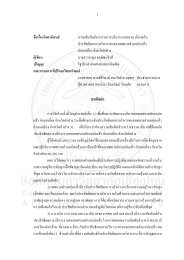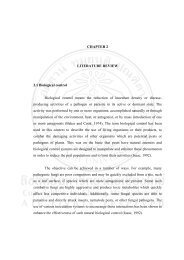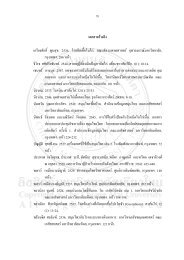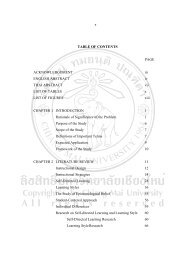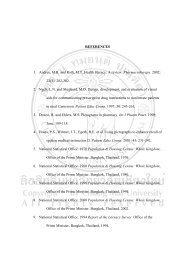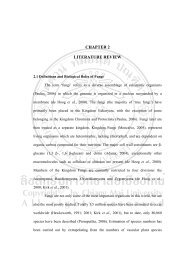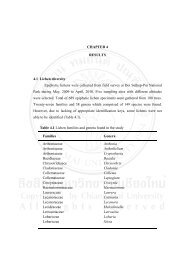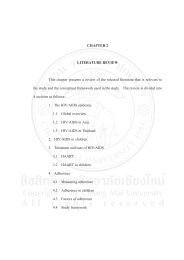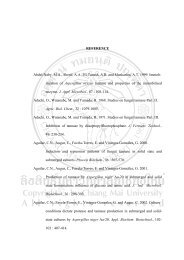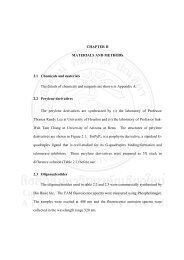prevalence and molecular characteristics of vibrio species in pre ...
prevalence and molecular characteristics of vibrio species in pre ...
prevalence and molecular characteristics of vibrio species in pre ...
You also want an ePaper? Increase the reach of your titles
YUMPU automatically turns print PDFs into web optimized ePapers that Google loves.
2.8 Human pathogenic Vibrio<br />
2.8.1 Vibrio cholerae<br />
25<br />
Cholera has been recognized as a fatal disease s<strong>in</strong>ce 1817 <strong>and</strong> six p<strong>and</strong>emics<br />
have already swept over the world (Suzita et al., 2009) <strong>and</strong> the 7 th <strong>and</strong> 8 th p<strong>and</strong>emics<br />
are still progress<strong>in</strong>g (Kaysner, 2000). Vibrio cholera is transmitted to humans via<br />
contam<strong>in</strong>ated food, water, raw seafood or direct <strong>in</strong>fection from food h<strong>and</strong>lers (Suzita<br />
et al., 2009, Thompson et al., 2004). Cholera is characterized by pr<strong>of</strong>use acute<br />
diarrhoea (rice water), vomit<strong>in</strong>g, dehydration <strong>and</strong> death with<strong>in</strong> 24 hours if left<br />
untreated (Suzita et al., 2009). The pathogenesis <strong>of</strong> this organism <strong>in</strong> the <strong>in</strong>test<strong>in</strong>e is<br />
characterized by adherence to the epithelium <strong>and</strong> production <strong>of</strong> an enterotox<strong>in</strong><br />
(cholera tox<strong>in</strong>) which leads to <strong>in</strong>tense watery diarrhoea. In addition to the tox<strong>in</strong>, the<br />
tox<strong>in</strong> coregulated pilus is essential for the micro colonization <strong>of</strong> the <strong>in</strong>test<strong>in</strong>al<br />
epithelium (Thompson et al., 2004).<br />
Currently more than 200 serogroups <strong>of</strong> V. cholera are identified based on the<br />
somatic O antigen. Vibrio cholera O1, O139, non-O1, non-O139 <strong>and</strong> O141 are the<br />
deferent O stra<strong>in</strong>s that cause diarrhoea throughout the world. V. cholerae O1 has two<br />
serogroups Inaba <strong>and</strong> Ogawa <strong>and</strong> two biotypes namely, Classical <strong>and</strong> El Tor (Ganesh<br />
et al., 2010, Suzita et al., 2009). Serogroup O1 <strong>and</strong> O139 are responsible for the<br />
epidemics <strong>and</strong> p<strong>and</strong>emic occurrences <strong>of</strong> cholera <strong>and</strong> non-O1 <strong>and</strong> non-O139 are less<br />
virulent forms found <strong>in</strong> patients. V. cholerae O141 causes cholera-like diarrhoea <strong>and</strong><br />
bacteraemia <strong>in</strong> the United States (Crump et al., 2003).<br />
2.8.2 Vibrio parahaemolyticus<br />
Vibrio parahaemolyticus is a Gram negative, mesophilic <strong>and</strong> halophilic rod-<br />
shaped bacterium found <strong>in</strong> the estuar<strong>in</strong>e environment, especially <strong>in</strong> shellfish, coastal<br />
fish <strong>and</strong> seafood. Consumption <strong>of</strong> raw, under cooked or contam<strong>in</strong>ated shellfish, fish<br />
<strong>and</strong> seafood is the method <strong>of</strong> transmission <strong>of</strong> this bacterium to humans. It causes<br />
gastroenteritis, nausea, watery diarrhoea, vomit<strong>in</strong>g, abdom<strong>in</strong>al cramps, low grade<br />
fever, chills <strong>and</strong> sometimes bloody diarrhoea (Cabanillas-Beltrán et al., 2006). V.<br />
parahaemolyticus produces tox<strong>in</strong>s: thermo-stable direct haemolys<strong>in</strong> (TDH), encoded




